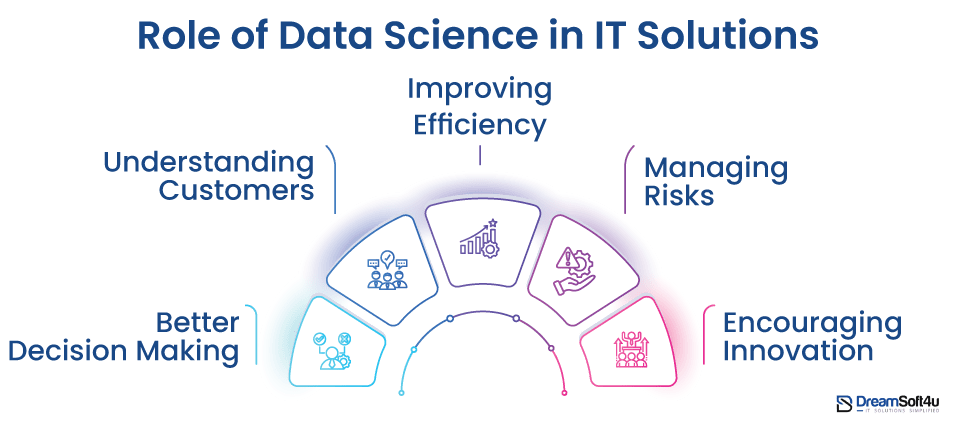With this rapidly growing world of digitalization, data science has made data one of the most significant assets for IT businesses. It’s at the core of any successful business, helping to find untapped opportunities, understand the market and customers, optimize operations, and drive more value in business. Plus, data science enables companies to stand out from the competition with its data-driven strategies.
Data science is not just a buzz anymore. It is a real-world part of businesses’ daily operations. And it is making a significant impact across industries. However, many companies did not understand the potential of utilizing data in their business.
That is why, in this blog, we will explore the role of data science and data analysis in business, how data analytics works, its key components, a roadmap to embrace data science, and the challenges to cater to.
By the end of this blog, you will know precisely the potential of data science and why it is needed for a successful business.
Table of Contents
ToggleWhat is Data Science and Analytics?
Data science and analytics is a way of using data to find meaningful insights and helpful information. It brings together different skills to study large amounts of data and uncover things businesses didn’t know before. Data is like currency. Companies can use it to improve other areas, such as supply chains, inventory, distribution, customer service, and marketing. The goal is to cut unnecessary costs while increasing profits. Experts in this field are required to use unique methods and tools to answer important questions and solve problems.
Here are some standard methods and tools utilized:
- Data mining
- Data modeling
- Business intelligence
- Predictive analytics
- Machine learning
- Software programming
- Data Engineering
How Does Data Science and Analytics Work?
Data science is not magic. There are specific steps to find valuable insights from the data, which helps businesses make intelligent decisions. Here is how it works:
1. Asking the Right Questions: You need to ask clear and specific questions to get the correct answers. This is where a data scientist helps frame better questions to get valuable answers.
2. Collect the Relevant Data: Once you have the right questions. The next step is gathering the correct data. Sometimes, businesses already have the data they need. But other times, they may need to find new sources.
3. Clean the Data: Not all data is perfect. Before analysis, data scientists remove or fix errors, missing values or incorrect information to ensure accurate results.
4. Analyze the Data: At this stage, the cleaned data is studied. Models are created to find patterns and insights. This process often involves testing different approaches to get the best results.
5. Understand the Results: Once the analysis is done, the data scientist explains the findings using charts, graphs and reports. This helps businesses understand the insights. And use them to make better decisions.
Role of Data Science in IT Solutions

Here are some key areas where data science plays a crucial role:
Better Decision-Making
One of the crucial roles of data science is in decision-making. It helps businesses make informed decisions by analyzing past data and finding patterns for the future. For example, a clothing store can analyze past sales. It helps to see which items are most prevalent during certain seasons. This allows them to stock the right products at the right time, which reduces waste and increases profits.
Understanding Customers
Businesses must know what their customers like and want. Data science helps by collecting and studying customer behaviour, such as shopping habits or preferences. For example, an online store can track what a customer browses. And suggest similar products, making shopping easier and more enjoyable. This personalized approach makes customers feel valued and increases their chances of returning.
Improving Efficiency
Data science helps businesses work more efficiently by identifying problems and fixing them early. For example, in a factory, machines can have sensors that collect data. If the data shows, a machine is about to break down. Maintenance teams can fix it before it stops working completely. This prevents delays, saves money on repairs and keeps production running smoothly.
Managing Risks
Every business faces risks. Whether it is fraud, financial loss or security threats. Data science helps companies identify risks before they become serious problems. For example, banks use data science to detect unusual transactions that might be fraud. Suppose someone tries to use a stolen credit card. The bank can block the transaction immediately. And protecting both the customer and the bank.
Encouraging Innovation
Businesses use data science to find new opportunities and create better products by analyzing customer feedback and market trends. Companies can see what people need but don’t have yet. For example, a mobile phone company might notice that customers want longer battery life. So they work on developing a phone with improved battery performance. This helps them stay ahead of competitors and attract more customers.
Key Components of a Successful Data Science Strategy in IT
Here are some key components of a successful data science strategy:
Collecting and Managing Data Properly
Data is the core part of data science. Businesses gather and store it in an organized and secure way. There are proper systems and processes set up for collecting, storing, and managing data with regulations to ensure the data quality is high and useful for analytics.
Building a Skilled Team
Another essential component is a highly skilled team. Who understand numbers, coding, and the specific industry they are working in. Companies should hire professionals who can analyze data. And use it to improve business decisions. They should also provide training to help their teams stay updated with new trends and technologies.
Using the Right Tools and Technology
It’s time to focus on utilizing the right tools and technologies that are required for data analysis, such as Machine learning software, data visualization programs and AI-based systems. It helps uncover valuable insights. Plus, staying up to date with the latest technology. Which ensures that businesses remain competitive and can make smarter decisions.
Creating a Data-Driven Mindset
Finally, a data-driven mindset is essential for a company. This means training staff to understand and trust data instead of relying only on experience or intuition. When data becomes a part of everyday decision-making, businesses can operate more efficiently and achieve better results.
Industrial Applications of Data Science
Here are some key ways businesses are using it:
- Identifying Unusual Patterns: Businesses use data science to detect unusual activities, such as fraud in banking or defects in manufacturing. This helps prevent financial losses and improves product quality.
- Understanding Customer Behavior: Companies analyze customer preferences and shopping habits, which are used to offer better products and services. This helps them create targeted marketing strategies. And improve customer satisfaction.
- Predicting Future Trends: Data science helps businesses forecast demand, sales and risks. For example, retailers use it to stock the right products. At the same time, healthcare uses it to predict disease outbreaks.
- Personalized Recommendations: Streaming services like Netflix and eCommerce sites like Amazon use data science. It helps to suggest movies or products based on user preferences, which makes experiences more personal.
- Sorting and Categorizing Data: Businesses deal with vast amounts of data. Which includes text, images and videos. Data science helps organize this information, which makes it easier to find and use efficiently.
- AI Chatbots and Virtual Assistants: Automated chatbots like Siri and Alexa. Customer service bots use data science to answer questions, assist users and handle tasks. Especially without human involvement, improving efficiency.
Roadmap to Adapt Data Science in IT Solutions

Here is the complete roadmap to adapt data science:
Step 1. Identify Business Goals and Data Needs
The very first step is defining clear business objectives. And understanding how data can help achieve them. Identify key areas where data-driven insights can improve decision-making, such as customer behaviour analysis, sales forecasting, and operational efficiency.
Step 2. Collect and Organize Data Efficiently
It is time to collect relevant data from different sources. Such as CRM systems and sales records. As well as external sources like market trends. Make sure that data is clean, well structured and stored in a secure, centralized system for easy access and analysis.
Step 3. Hire a Skilled Data Science Team
Not every business has technical expertise. That is why it is better to hire an experienced data science team, which helps professionals get the work done. Hiring a data science team can be cost-effective as compared to building an in-house team.
Step 4. Implement Data Analytics & Machine Learning
Use data analytics to understand past trends, predict future outcomes and make data-driven decisions. Leverage machine learning models and AI tools to automate processes, optimize operations, and enhance business efficiency.
Step 5. Use Data Visualization for Better Decision-Making
Once the data analytics are implemented and valuable insights are found. Then, turn that raw data into easy-to-understand visual formats. Such as dashboards, graphs and real-time analytics. Which helps teams and stakeholders quickly grasp insights and take action.
Step 6. Integrate Data Science into Business Operations
Apply data insights across different business functions. Such as marketing, supply chain management and customer service. Automate workflows and continuously refine data models. Which enhances productivity and decision-making.
Step 7. Ensure Data Security & Compliance
Data protection laws like GDPR and CCPA should be followed to safeguard customer privacy. Implement encryption, secure data storage, and ethical AI practices to build trust and prevent security breaches.
Step 8. Monitor Performance & Improve Continuously
Regularly evaluate the impact of data-driven strategies, update machine learning models and stay informed about the latest trends in data science. Continuous learning and improvement will help businesses maintain a competitive edge.
Challenges of Implementing Data Science in IT
Here are some key challenges that businesses face in data science:
Data Quality Issues
If data is messy, incomplete or incorrect. It can lead to wrong conclusions. Problems like missing details, duplicate records or unstructured formats. Which makes it harder to prepare and analyze data accurately.
Limited Access to Data
Getting the correct data can be complex due to company restrictions, privacy laws, or technical limitations. Many businesses struggle to combine data from different sources like old systems, online platforms, or cloud storage.
Handling Complex Data
Modern data comes in different forms, such as text, images, videos and live streams. Analyzing such vast and varied data requires special tools and substantial computing power, which can be challenging to manage.
Lack of Skilled Professionals
Many professionals lack expertise in key areas like machine learning, big data tools and cloud computing. This skills gap slows down innovation and project success.
Ethical and Legal Concerns
Strict data privacy laws like GDPR and CCPA control how businesses collect and use customer data. Failing to follow these rules can result in legal trouble and harm a company’s reputation.
Future of Data Science
Here are some of the latest stats to understand the future of data science:
- The data science industry is growing fast and is expected to reach $322.9 billion by 2026 with a 27.7% annual growth rate.
- The amount of data is expanding rapidly, and by 2025, there will be 181 zettabytes of data.
- Many industries are adopting big data analytics. For example, 56% of healthcare centres now use predictive analytics to improve decision-making and patient care.
- 87% of companies are increasing their investments in data, proving that data science is becoming essential for business success.
- Managing massive amounts of data is challenging. 43% of IT managers worry that their current systems may not be able to handle future data demands. This shows the need for better data science tools and technology.
Planning to utilize data science in your business?
Our team of skilled professionals offers end-to-end solutions
Conclusion
Data science is transforming industries by leveraging data to improve decision-making. Now, it has become a part of people’s everyday lives. However, with great power comes responsibility, as data privacy and security remain critical challenges as AI and machine learning continue to evolve. This technology will unlock even greater possibilities, which makes it essential for businesses and professionals to adapt. With its growing influence, it will continue shaping the future, driving innovation, and improving lives. We hope this guide helps you understand the role of data in IT solutions, its benefits, industrial challenges, and steps to implement it. Now, it’s your turn to hire an experienced team of skilled professionals and utilize data to get the most out of it.
FAQs
Q1. What is data science, and why is it essential for IT solutions?
Data science is the process of analyzing and interpreting large datasets, which uncover insights. It helps IT solutions improve decision-making.
Q2. How does data science contribute to better decision-making in businesses?
It analyzes past data, identifies trends and predicts future outcomes, which enables businesses to make data-driven decisions.
Q3. What are some real-world applications of data science in IT?
Some real-world applications are fraud detection, customer behaviour analysis, AI chatbots, predictive analytics, cybersecurity and IT system optimization.
Q4. What are the biggest challenges businesses face when adopting data science?
Some common challenges are data quality issues, lack of skilled professionals, integration complexities, high costs and data privacy concerns.
Q5. What is the future of data science in IT solutions?
Increased automation, AI-driven analytics, real-time data processing, enhanced security, and more personalized IT services.





















